Profile
François Diederich
Professor of Chemistry and Applied Biosciences, ETH Zürich, Switzerland
Abstract
Organic & Biomolecular Chemistry profiles Professor François Diederich
| 1979 University of Heidelberg, Dr. rer. nat., Supervisor Professor Heinz A. Staab 1979–1981 University of California at Los Angeles (UCLA) Postdoctoral fellow, Supervisor Professor Orville L. Chapman 1981–1985 Research Associate, Max-Planck-Institut für medizinische Forschung, Heidelberg 1985 University of Heidelberg, Dr. habil. 1985 UCLA, Acting Associate Professor 1987 UCLA, Associate Professor 1989 UCLA, Full Professor of Organic and Bioorganic Chemistry 1992 ETH Zürich, Professor of Organic Chemistry 2002 to date ETH Zürich, Head of the new Department of Chemistry and Applied Biosciences |
François Diederich was born in 1952 in Ettelbrück, a little city in the Grand-Duchy of Luxembourg. He lives with his wife Georgine, also from Luxembourg, in the city of Dietikon near Zürich. His two children Christophe (22) and Catherine (20) are currently on the verge of leaving the family home to pursue lives of their own. His hobbies have changed over time; thus he has turned from a very active soccer player into a true couch-potato-style soccer fan. His love for music is focused on opera. Most of all, he enjoys daily readings of novels, from the great classics to the modern authors from all over the world.
When did you first realize that you wanted to work in chemistry?
During the last three high school years in the Lycée classique in Diekirch, Luxembourg, I was enrolled in the mathematics and natural sciences section. At that time, I very much enjoyed physics, mathematics and chemistry—but in the end, I decided on chemistry since I had become particularly attached to the combination of theoretical and practical work—in particular the craftsmanship side—this field had to offer.
Who was the first person to inspire you to research in chemistry?
In high school, I enjoyed being taught by an exceptionally gifted and inspiring chemistry teacher, Mr Jean Mootz. His courses were spiced with spectacular experiments; furthermore, he made it possible on free afternoons to pursue little projects in the well-equipped chemistry laboratories of the school. This way, when I attended the University for chemistry studies, I had already become well acquainted with most of the qualitative elemental analyses that were the subject of the lab courses in the first year.
Tell us something about the areas of chemistry you are currently researching?
I have been very much influenced by my six-year stay as a doctoral student and research associate at the Max-Planck-Institute for medical research in Heidelberg. At that time, this institute provided an extraordinarily broad interdisciplinary learning and research environment expanding from organic chemistry to physics, to biophysics, molecular biology and physiology. My program reflects this background. Two main avenues are currently being pursued, the first being the development of the chemistry and advanced materials properties of large, carbon-rich π-systems. These include the fullerenes as well as one-, two- and three-dimensional acetylenic networks. The second main area is the quantitative investigation of molecular recognition phenomena in chemistry and biology using both artificial and protein receptors. We have become quite interested in X-ray structure-based de novo design of non-peptidic enzyme inhibitors, a chemical-structure-intuition-based approach to lead generation and optimisation in medicinal chemistry. All our research projects are strongly synthesis-driven, and their common denominator is the introduction of specific functions into new molecules and supramolecules by rational design. Molecular aesthetics considerations also affect target selection.
Why did you decide to research in these areas of chemistry?
My interest in carbon-rich molecules dates back to my doctoral research on the synthesis and properties of kekulene (C48H24), one of the largest polycyclic aromatic hydrocarbons known at that time. Stimulated by the total synthesis of C60, which had been pursued since 1981 in the laboratories of my postdoctoral advisor Professor Orville Chapman at UCLA, I became interested in the mid 1980s in the design and synthesis of novel acetylenic molecular and polymeric carbon allotropes. In 1989, we discovered that some of our acetylenic rings, the cyclocarbons, were undergoing specific gas-phase ion–molecule coalescence reactions to produce fullerenes and this finding led us naturally into our ongoing program in covalent fullerene chemistry.
I have pursued molecular recognition studies since the beginning of my independent career in 1981 at the Max-Planck-Institute. The first objective was the mimicking of aromatic binding pockets at enzyme active sites with water-soluble cyclophane receptors. Later, we used the emerging dendrimer technology to mimic the protein shell around enzyme active sites. In the 1990s, we became increasingly interested in the recognition of small biomolecules, such as amino acids, sugars and steroids, by artificial receptors. In the early 1990s, studies with biological receptors were added to our program with the aim of advancing rational methods for lead generation and optimisation in medicinal chemistry.
Where would you like to see your research in both the short and long term?
Molecular recognition studies in our group are now almost exclusively done with biological receptors. We select our targets for structure-based design increasingly in disease areas that are neglected by the mainstream industry, such as malaria. Having reached a high success rate in developing non-peptidic lead structures for the inhibition for enzymes with deep concave binding pockets, we are now addressing the more ambitious challenge of protein surface recognition by small molecules.
In our fullerene research, we continue the development of regio- and stereoselective multiple functionalisation methods. Increasingly, fullerene derivatives are introduced as functional components into advanced materials that are subsequently investigated in interdisciplinary collaborations. The generation of exceptional optoelectronic molecular properties by design also continues to be at the center of our acetylenic scaffolding research.
What would you most like to achieve in your lifetime in chemistry?
I'd love to see one of our enzyme inhibitors, resulting from X-ray structure-based de novo design, making it to the market as a drug. I also hope to demonstrate in the coming years that rational, structure-based design methods are powerful in providing small-molecule inhibitors of protein–protein association phenomena. New acetylene- and fullerene-based carbon allotropes represent our key target in synthesis.
What do you find most enjoyable about your job on a daily basis?
I am addicted to life-long learning. Learning how to improve rational knowledge-based methods to introduce a desired function and property into a synthetic molecule or a supramolecular assembly fascinates me. Having the opportunity on a daily basis to learn new science from gifted diploma and doctoral students as well as from postdoctoral co-workers is equally exciting.
What frequently annoys you about your job?
I often feel helpless in the face of the incredible flood of requests for reviewing and refereeing at all levels, manuscripts from dozens of journals, grant applications, nominations for promotions, award nominations, departmental and university evaluations.… In order to maintain a productive research program of my own, I need increasingly to turn down such requests, in particular if they are outside my key areas of expertise. In my view, the scientific community is straining the peer review processing to its limits; it is increasingly turning into a bureaucratic machinery. And, as illustrated by recent sad examples from solid-state physics, it does not help in eliminating fraud; possibly because scientists are so overloaded with review requests that they are unable to spend the necessary time required for a single, sound review.
Which scientist/chemist do you admire through history and why?
I admire Professor Vladimir Prelog for his scientific achievements, his natural leadership and his exceptionally fine humour. I also admire Professor Donald Cram for his bold creativity, his optimism and his firm belief that one should not deviate from pursuing a scientific target identified as being meritorious.
If you could successfully solve any scientific problem, what would it be and why?
Developing room-temperature organic superconductors must be one of the dreams of a researcher involved in the development of new π-systems. Making selective protein surface recognition by small nonpeptidic molecules highly effective would open up an entire generation of new targets for drug development.
Professor Diederich can be contacted at ETH: Email: E-mail: diederich@org.chem.ethz.ch; ; http://www.chem.ethz.ch/D-CHEFootnote |
| † Photographs show Professor Diederich, the Zurich skyline, the new chemistry building at ETH and Professor Diederich with C. Thilgen. |
| This journal is © The Royal Society of Chemistry 2003 |




